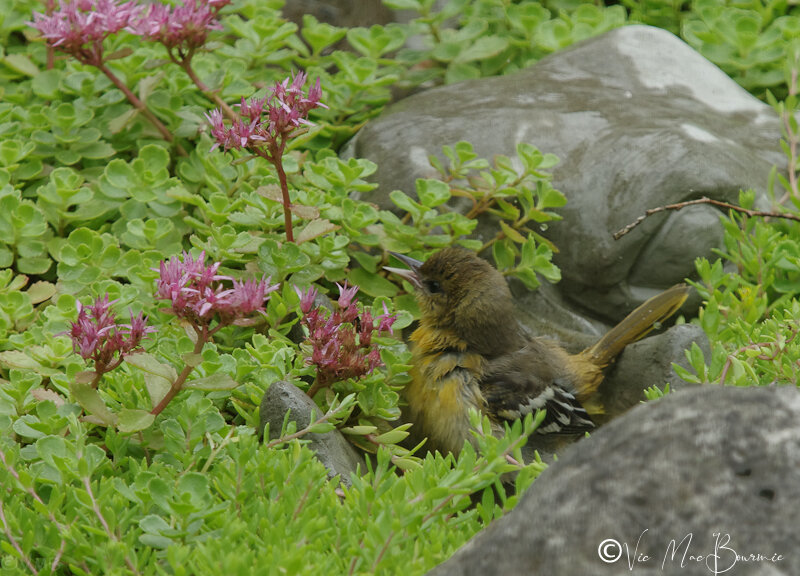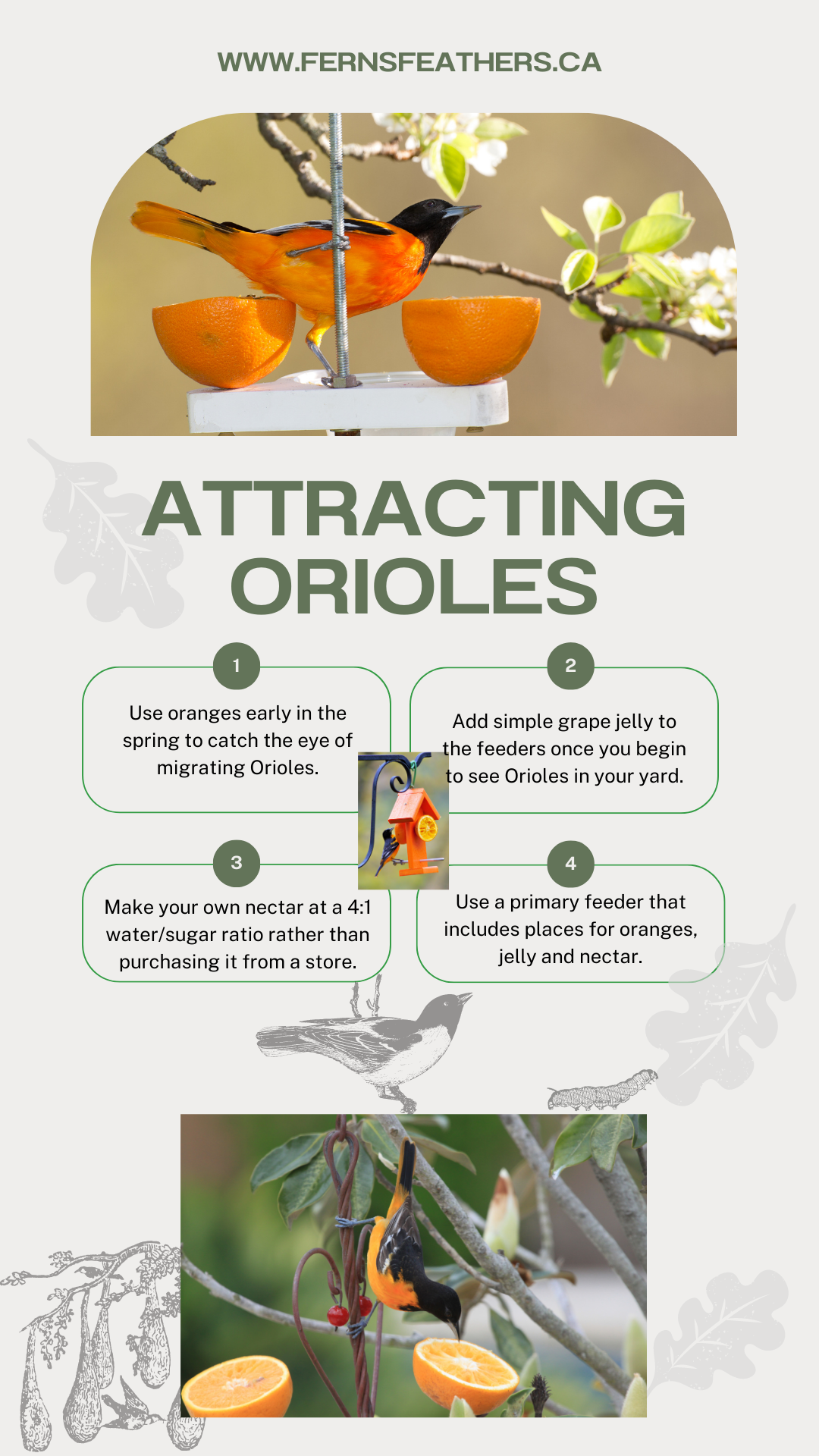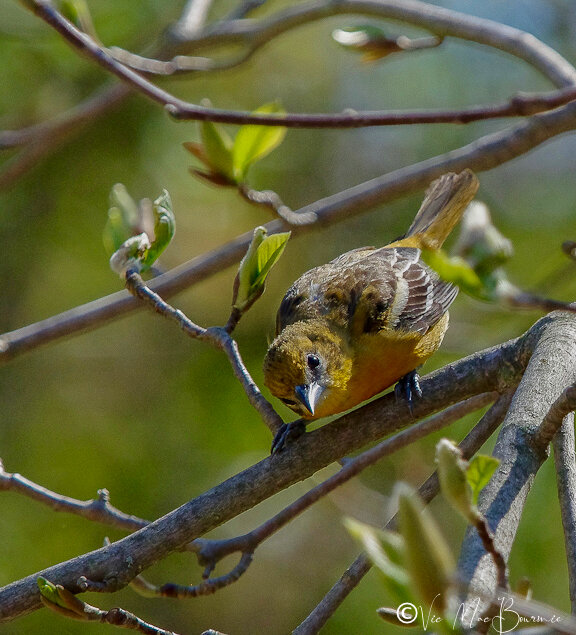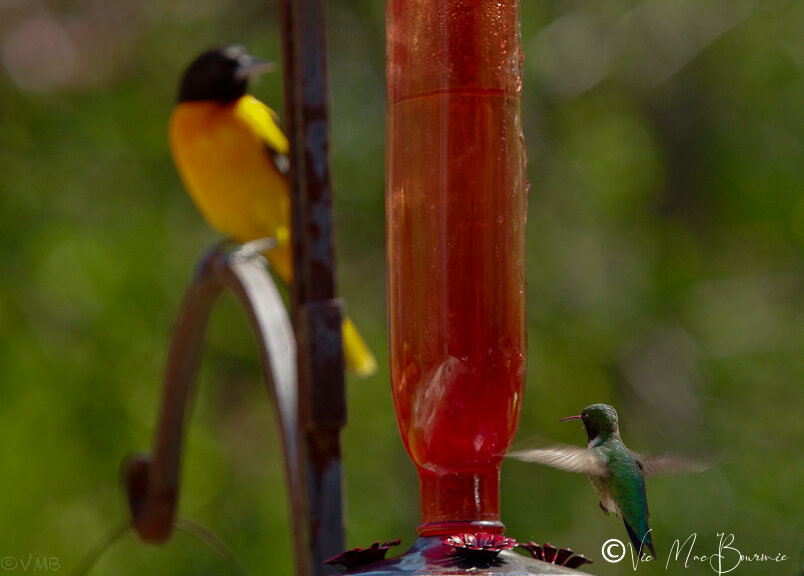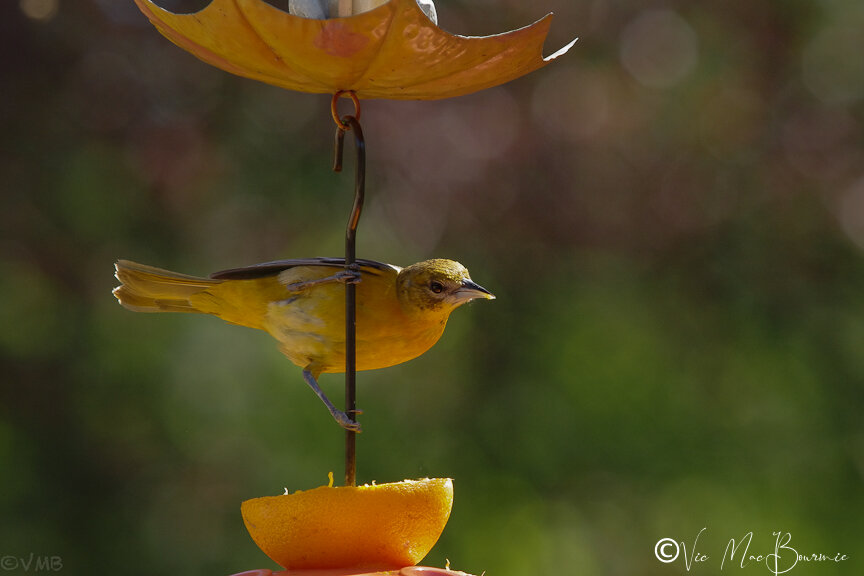How to attract Orioles with oranges, jelly and insects
Go natural: Provide insects and berries for Orioles
I’m sitting in my home office in the middle of May with a light dusting of snow on the ground watching Baltimore Orioles working one of the orange halves I left out on the feeder for them
Last year, I remember as many as seven swarming the feeder. They were feasting on oranges and nectar from a commercial feeder that I had put out for them to catch their attention as they migrated back to their more northern summer breeding grounds here in Canada, from winters in Mexico, Central and South America.
If you want to attract Orioles and keep them around year round, you’ll have to make sure your Woodland provides them with everything they need so they decide to call it home. That includes an upper tree canopy where they often build their nests.
While I get great enjoyment from my bird feeding stations, providing natural food sources to our feathered friends is always the goal we should aspire to in our gardens. I have written a comprehensive post on feeding birds naturally. You can read about it here.
Orioles live in open woodlands particularly those with deciduous trees and lots of insects.
Oranges will go a long way to entice Orioles to visit your yard in spring, but grape jelly, nectar (in the same 4 to 1 ratio of water and sugar used to attract hummingbirds) provided in commercial feeders and berries in your garden from native trees and shrubs will help to convince the birds to stay around all summer. Don’t forget to provide an abundance of insects, including meal worms, which is the main food of Orioles when feeding their nestlings and throughout the remainder of the summer.
A male oriole works an orange half on the top of an Oriole feeder filled with the same sugar water mixture used for hummingbird feeders.
Here in Southern Ontario and Eastern United States we are limited to the Baltimore and orchard orioles. There are actually nine orioles throughout the United States, but only five are common.
The Bullock’s is found throughout Western Canada and the United States.
Once you’ve got them, and providing you give them the requirements they need, they often return year after year to raise their young.
More on what are the best Oriole feeders here.
Spring migration troubles 2021
Of Note: In the spring of 2021 many homeowners who normally have had Baltimore Orioles in their gardens are reporting that the birds either did not show up or appeared for only a day or two and moved on never to be seen again. I usually have a large number of orioles in the garden throughout the summer raising their young. This year, although a few passed through, none stayed around for more than a day or two. I have seen similar reports of decreases in Baltimore Oriole numbers throughout southern Ontario into northeastern U.S.
There appears to be no obvious reason for this concerning turn of events. A late cold spell that ripped through the Great Lakes area right around migration time brought freezing temperatures, including heavy snow, which may have resulted in fewer birds surviving migration or more birds choosing to nest further south. I will try to update this page if there is any more news on the plight of the Orioles.
A young Oriole enjoys a bath in one of our on-ground water sources that happens to be a concrete antler belonging to our concrete moose named Bruce (as in Springsteen) the moose.
It wasn’t too long ago when our Woodland garden was completely devoid of Orioles. Not that they weren’t around. People regularly talked about seeing them in the Conservation area surrounding us. I just never saw them in my garden.
Then I got serious about enticing these beautifully coloured birds into our garden.
Oriole nests are elaborate sac-shaped works of art
Now, they are not only here regularly in the spring and throughout the summer, a pair have even nested in a large maple at the front of our property. I don’t always find their nests, but I often see the young birds with their parents.
Orioles can take up to 12 days to build their elaborate, pendulous sac-shaped nests on the ends of branches in tall trees often in more open areas. Their nests are unique when it comes to North American birds’ nests.
In spring, the female oriole build’s her nest with thin, intertwined fibers that form what might seem like a delicate pouch but, in fact, can hold up to seven eggs.
For more information on how orioles build their nest check out audubon’s highly informative article on their site here.
Last year, a mother brought her entire brood to our on-ground water source where they had a great time splashing around in the ears of our concrete moose.
All it took to get them here originally was a couple of oranges cut in half and placed in areas where the Orioles are likely to see them. Now our neighbours have joined in to the excitement and put orange slices around their yard as well.
Once you have them, it’s time to add grape jelly to your yard. It has to be basic grape jelly, not a jam. You can buy special oriole jelly in plastic bottles at many good bird stores, but just buy a good grape jelly. I like to use Welch’s grape jelly, but any no-name jellies should be fine. Mix it with a little water and the Orioles will lap it up often choosing the jelly over the orange halves.
Orioles are attracted to the colour orange, so many of today’s feeders use the colour to catch the bird’s attention.
One trick that I like to use is after the orioles are finished with the orange half, I fill it with jelly. They seem to appreciate my effort. It’s a constant exchange of old oranges with new ones, and filling the spent oranges with grape jelly.
Five cool facts about orioles
• Orioles are in the same family as blackbirds and meadowlarks and are most often seen perched at the tops of trees or flitting through the upper foliage looking for insects.
• Their chatter is quite distinctive as is their call. Once you have heard it, you are unlikely to forget it.
• Watch your peas. Orioles enjoy fresh or frozen or dried peas
• Orioles live up to 11 years in the wild and longer in captivity.
• Female orioles become a deeper orange every time they molt. Older females can be almost as bright as their male counterparts
• Orioles got their names from the black and orange of Lord Baltimore’s family crest, which is similar to the family’s crest
• the Baltimore oriole is Maryland’s state bird
• Orioles have distinct alarm calls to warn of predators, but will not hesitate to mob and harass predators that threaten or come near nests.
Oriole feeders have come a long way
Many modern feeders will provide areas to mount oranges as well as cavities to put the jelly into. Some feeders also offer the Orioles several choices, including jelly, orange halves and nectar.
Some, such as the Birds Choice Flower Oriole Bird Feeder include a reservoir to hold grape jelly as well as places to mount orange halves. Look for feeders that also provide perches for several of the birds to comfortably and safely perch while they are eating. It’s not uncommon to have several at your feeders at once.
The nectar that is used for orioles is the same as the nectar used for hummingbirds. It should be made the same way – 4 parts of water to one part of sugar.
I like to boil my water first and then measure out the 4:1 ratio. The boiling water helps to dissolve the sugar more perfectly and seems to keep my feeders’ nectar clear longer. Remember to let it cool to room temperature before filling your nectar feeders.
Don’t be surprised if the orioles start to feed from your hummingbird feeders. They are a regular at my feeders, even when they struggle to fit on them properly.
In saying that, however, it’s not uncommon for our hummingbirds to drink from the oriole feeder.
Orioles love moving water
Don’t underestimate the value of moving water. Although orioles get much of their water needs filled by nectar from our feeders and plants, water still plays an important part in attracting these beautiful birds. They are especially attracted to the sight and sound of moving water, whether it’s a fountain, a dripper or a bubbler. I wrote a full article about converting a dripper into a solar fountain. You can read it here.
Five of a total of seven Orioles pictured here taking advantage of our various feeders that included orange halves, home-made jelly feeders and a nectar feeder.
In summer meal worms are an excellent choice for Orioles
Finally, once you have attracted the Orioles, you will need to be prepared to change their diet as summer approaches. You may notice them using your orange and jelly feeders less and less. That’s when to start shifting what you are feeding them from oranges and jelly to meal worms, either live ones (which are ideal) or dried ones. It’s a good idea to rehydrate the dried meal worms with some water before putting them out in your feeders. Or, put them in a dish and add a little water to rehydrate them. This makes it easier for the birds to swallow them.
Both types are available at bird-feeding stores or through Amazon. Feeding meal worms will not only attract Orioles to your garden. They are the prime source of food for Bluebirds at a feeder as well as robins and other insect eating birds.
Special meal worm feeders are also available. Because squirrels are not interested in meal worms, these feeders can hang anywhere in the garden including from nearby tree branches.
The Baltimore Oriole spends its winters in florida and farther south in Central America. They migrate north to breed throughout the northeast United States and into southern parts of Canada.
Insects are the birds’ primary food source in summer
Although they are attracted to Oranges and jellies on their migration routes, their real food is a variety of insects.
The Orioles that visit our gardens are using the oranges and jelly as a quick burst of energy. By the summer, when they are raising their young, they spend much of their time foraging for insects to feed their babies. The parents will still come to the feeders for quick bursts of energy, but they may also almost disappear if they are not nesting nearby.
Besides mealworms, Orioles will also eat wasps and other insects. It is vital to avoid using pesticides in the garden to ensure a large supply of insects for these birds. During the summer, when orioles are feeding their young, insects may provide up to 90 per cent of an oriole’s diet.
Native shrubs and bushes that produce an abundance of berries are excellent food sources for these birds. Consider planting elderberries, blueberries, blackberries, serviceberries and raspberries just to name a few. I have written an entire article about the importance of serviceberries in our wildlife gardens. You can read it here.
Although oranges are their favourite fruit, they will also eat apple, peaches, bananas and berries.
Providing them with special suet mixes that include fruit pieces and berries is a good source of high energy for them.
Plant bright, but dark-coloured fruits such as mulberries, cherries and purple grapes as well as raspberries. They also like flowers that produce high quantities of nectar including vines such as trumpet vines.
As an Amazon Associate I earn from qualifying purchases. This page contains affiliate links. If you purchase a product through one of them, I will receive a commission (at no additional cost to you) I only endorse products I have either used, have complete confidence in, or have experience with the manufacturer. Thank you for your support.


